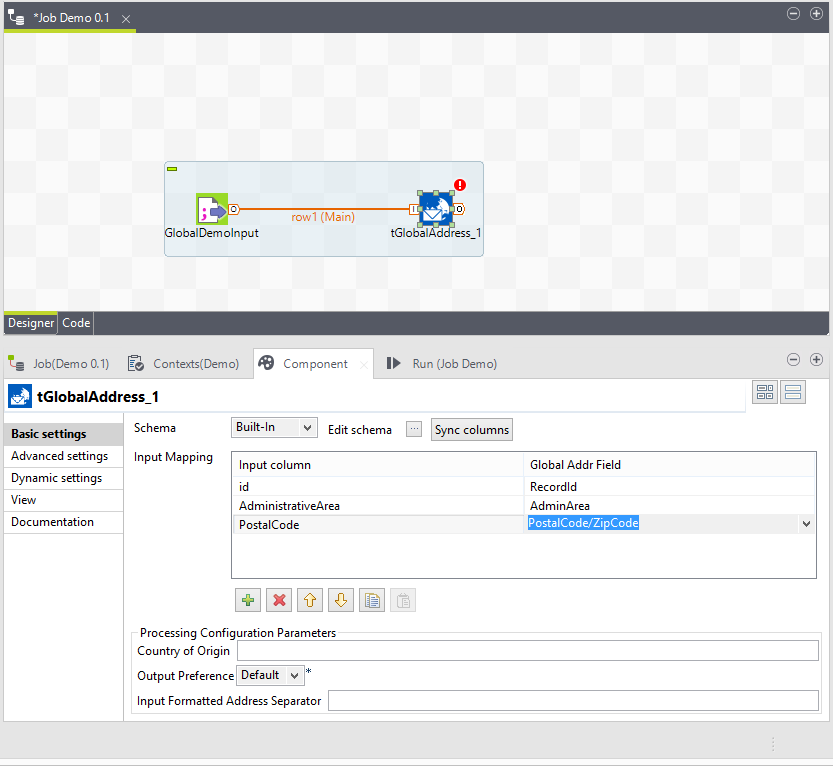This wiki is no longer being updated as of December 10, 2025.
|
Talend:Global Address:Basic Settings
← Data Quality Components for Talend
| Global Address Navigation | |||
|---|---|---|---|
| Overview | |||
| |||
| Result Codes |

Schema
- Built-In
- This uses the built-in schema.
- Repository
- This will use a schema from a repository.
Edit Schema
This menu lets you modify what data type you are outputting, depending on the output connector.
The input schema will be on the left and the output schema of the component on the right. You can change the schema order, save the schema as an XML template, load a schema template from XML, etc.
Sync Columns
Clicking the Sync Columns button will merge the input schema with the output schema.
Input Mapping
Map the input to their respective fields in Global Address.
- RecordId
- A unique identifier for the current record. Use this to match the record submitted with the record returned. It will return what is inputted.
- AddressLine1-8
- Input fields for the address. Should contain the delivery address information (house number, thoroughfare, building, suite, etc.) but should not contain locality information (locality, administrative area, postal code, etc.) which have their own inputs.
- At least one Address Line is required.
- AdminArea
- Administrative Area. The most common geographic data element.
- US Term: State.
- Canadian Term: Province.
- Country
- The country name, abbreviation, or code.
- Dependent Locality
- A smaller population center data element. Depends on the Locality element.
- US Term: Urbanization.
- In terms of US Addresses, this element applies only to Puerto Rican addresses. It is used to break ties when a ZIP Code is linked to multiple instances of the same address.
- Double-Dependent Locality
- The smallest population center data element. Depends on the Locality and Dependent Locality elements.
- Locality
- The most common population center data element.
- US Term: City.
- Canadian Term: Municipality.
- Organization
- The name of any organization associated with the address record.
- PostalCode/ZipCode
- The complete postal code for a particular delivery point.
- US Term: ZIP.
- Canadian Term: Postcode.
- Sub-National Area
- The administrative region within a country on an arbitrary level below that of the sovereign state.
- Sub-Administrative Area
- The smallest geographic data element.
- US Term: County.
Processing Configuration Parameters
- Country of Origin
- This is used to determine whether or not to include the country name as the last line in Formatted Address
- Acceptable Value: Any valid ISO-3166-1 Alpha-2, ISO-3166-1 Alpha-3, or ISO-3166-1 Numeric code.
- If blank, invalid, or the same as the destination country, then the destination country is not appended to the end of the formatted address.
- If valid and different from the destination country, then the destination country is appended to the formatted address.
- US or US Territory:
- If Country of Origin and destination country being verified are both US or US Territories then the country will not be appended to Formatted Address.
- US Territories will have “Unite States of America” appended if the Country of Origin is not a US Territory, but the Country Name and ISO codes will be that of the territory.
- Canada is treated like any other non-US Territory.
- Output Preference
- The character set to use to format the output data.
- Match Input: Return the output in the same script used in the input.
- Latin: Convert all output to the latin character set.
- Input Formatted Address Separator
- The delimiter to use to separate multiple lines in the data returned by Formatted Address.